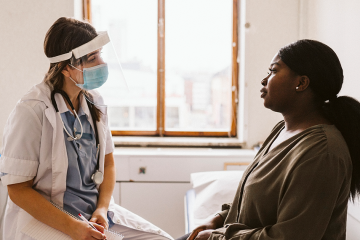
Maternal Death Among U.S. Black Women
Date
March 9, 2023
Author
U.S. Black women are over three times more likely to die in pregnancy or postpartum than white women.
In the United States, non-Hispanic Black women were 3.5 times more likely to die during pregnancy or shortly after childbirth than non-Hispanic white women in 2016 and 2017. Ending Black maternal mortality in America involves addressing structural racism—that is, those aspects of social, political, economic, and health care systems that reinforce inequity, researchers say.
Cardiovascular disorders like preeclampsia are far more likely to kill Black women.
Black-white disparities in maternal death are concentrated among a few causes, research shows (see figure). Black women were five times more likely to die from postpartum cardiomyopathy (a form of heart failure) and preeclampsia and eclampsia (blood pressure disorders) than white women, according to the 2016-2017 data.
Pregnant and postpartum Black women were also more than two times more likely than white women to die of hemorrhage (severe bleeding) or embolism (blood vessel blockage).
FIGURE. Preeclampsia/Eclampsia Is the Leading Cause of Black Maternal Death
U.S. maternal deaths per 100,000 live births for five leading causes of maternal death by race/ethnicity, 2016-2017
Notes: Maternal deaths include those during pregnancy and up to 42 days postpartum. For Hispanic women, the values for preeclampsia/eclampsia, obstetric hemorrhage, postpartum cardiomyopathy, and other complications of surgery and procedures are not statistically reliable, based on 10-19 deaths in the numerator.
Source: Table 2, Marian F. MacDorman et al., “Racial and Ethnic Disparities in Maternal Mortality in the United States Using Enhanced Vital Records, 2016‒2017,” American Journal of Public Health 111, no. 9 (2021): 1673-81.
Even with more education and income, Black women are more likely to die or suffer severe childbirth complications.
In New York City, non-Hispanic Black women were eight times more likely to die of pregnancy-related causes than non-Hispanic white women between 2011 and 2015, a study by the New York City Health Department showed.
While women with more education, income, and wealth tend to fare better in pregnancy, college-educated Black women in New York City were more than twice as likely to suffer severe complications from childbirth than white women without a high school diploma from 2008 to 2012, another Health Department study documents.
In California, Black mothers with the highest incomes were more likely to have severe childbirth complications than white mothers with the lowest incomes, finds a study of data from 2007 to 2016.
Most pregnancy-related deaths in the United States are preventable.
The Centers for Disease Control and Prevention determined that 84% of all maternal deaths from 2017 to 2019 were preventable, in a study using data from 36 states.
Early diagnosis and treatment of preeclampsia, eclampsia, embolism, and cardiomyopathy are crucial, given the outsize role of these disorders in Black maternal death, says Marie Thoma, a reproductive and perinatal epidemiologist and population health scientist at the University of Maryland. “We need new models of care before, during, and after birth to address these inequities,” she says.
In 2021, COVID-19 led to dramatic increases in maternal death for all U.S. women. The maternal mortality rate for Black women that year—69.9 deaths per 100,000 live births—was 2.6 times the rate for white women (26.6).
Preventing racial inequities means questioning systems, policies, and social structures.
Addressing the stark racial inequities in maternal death requires fundamentally reorienting the current approach to health care, argues Rachel Hardeman, Director of the Center for Antiracism Research for Health Equity at the University of Minnesota. Research and action must be grounded in the understanding that racism is at the root of health inequities, she says.
“We must first ask, ‘How do systems, policies, and social structures combine to create the conditions for poor health?’ rather than asking, ‘What’s wrong with people of color that makes them die younger and at higher rates and suffer more illnesses?’”
The environments where people are born, live, learn, work, play, and seek health care take a collective toll on their health, a wide body of evidence shows.
“The lived experience of racism gets under the skin,” says Paris “Dr. AJ” Adkins-Jackson, Assistant Professor of Epidemiology and Sociomedical Sciences at Columbia University.
The story of CDC epidemiologist Dr. Shalon Irving, who consulted multiple providers but died from blood pressure complications three weeks after childbirth, shows us the devastating effects of the gaslighting that often occurs when individuals who are racialized as Black interact with the U.S. health care system, Dr. AJ explains.
“These stories and data show us that it’s not about the implicit bias of one health care provider, but a systemic problem that requires upstream intervention and solutions,” she says.
For More Information
These PRB resources provide context on maternal health in the United States.



